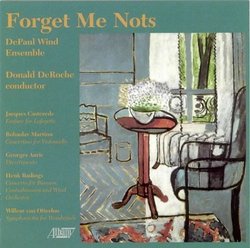CD Details
All Artists: Georges Auric, Henk Badings, Jacques Casterede, Bohuslav Martinu, Willem Van Otterloo, Donald DeRoche, DePaul University Wind Ensemble
Title: Forget Me Nots
Members Wishing: 0
Total Copies: 0
Label: Albany Records
Release Date: 4/27/2004
Genres: Jazz, Special Interest, Classical
Styles: Swing Jazz, Marches, Forms & Genres, Concertos, Instruments, Strings, Symphonies
Number of Discs: 1
SwapaCD Credits: 1
UPC: 034061062820 |
Synopsis
Album DescriptionCasterede?s fanfare is a tribute to the Marquis de Lafayette. In it Casterede has chosen the style of an 18th century military band in his fanfare for brass and percussion. In 1924, while in Paris, Martinu wrote the first of several pieces for solo cello. This Concertino was written with a wind/percussion accompaniment. In 1965, Robert Boudreau, conductor of the American Wind Symphony, visited Europe to search for new music for his ensemble. During a discussion about significant composers of the 20th century, the name of Georges Auric came up. At the time, Auric was directing the Paris Opera and the Opera Comique, but was doing little composing. Boudreau knew that Auric had stopped actively composing, but visited the composer in any case and presented his case for expanding the repertoire for winds. After hearing what Boudreau had to say about his ensemble, Auric agreed to write a piece, and presented it within a few weeks. As the title suggests, Divertimento is! an entertaining work, but as Boudreau says, "a virtuosic one, full of sprightly and sometimes exotic wind figuration and peppered with sparkling contributions from pitched and unpitched percussion." Once again, the Dutch composer Henk Badings (1907-1987) was also commissioned by Boudreau to write his piece for the American Wind Symphony. Between 1963 and 1985, Boudreau commissioned a large number of works from Mr. Badings. The Double Concerto for Bassoon and Contrabassoon is one of the earlier works, having been written in 1964. It is subtitled "In Memoriam Paul Hindemith". The Dutch composer/conductor Willem van Otterloo wrote his Little Symphony for Wind Instruments in 1943. It is written in a post-romantic style and is accessible, running the gamut from charming, to brilliant to reflective.
| |
CD Reviews
A Fine Wind Band Program J Scott Morrison | Middlebury VT, USA | 05/05/2004 (5 out of 5 stars) "Generally I don't read the booklet that comes with a new CD before I give it a listen. With this one, I simply grabbed it, not even having read the list of works, stuck it in my Discman and headed out for a walk. Imagine my surprise on listening to the first selection, which sounded to me like a brass-and-percussion fanfare from 18th-century France, when strains of 'The Star-Spangled Banner' showed up. Only after I returned from my walk did I learn that this rousing piece was entitled 'Fanfare for Lafayette,' written by Jacques Casterede, about whom there was nothing in the notes. Be that as it may, this four-minute piece is a terrific curtain raiser. I intend to bring it to the attention of a wind band conductor I know.The rest of the program consists of not-very-familiar works by reasonably familiar composers: Martinu, Auric, Henk Badings, and Willem van Otterloo. Only the latter is not particularly well-known, although he is known to those of us of a certain age because of his work as a conductor in the middle part of the century. And because Donald DeRoche, the imaginative conductor of this fine ensemble from DePaul University, included a van Otterloo piece on the their fine 'Ragtimes and Serenades' CD. On this disc, van Otterloo's 'Symphonietta for Woodwinds' is given a nice reading. For me the high points on this CD are the three middle works. Martinu's 'Concertino for Violoncello, Winds and Percussion' with the expert but slightly dry-toned cellist, Christopher Costanza, is a very skillfully orchestrated concerto pitting the cello against a virtuosic wind and percussion group, an interesting combination that works quite well. This is a loose-knit piece in one movement which shows the French influence of Martinu's stay in Paris after leaving Czechoslovakia. 'Divertimento' by Georges Auric is one of the last pieces he wrote. In fact, according to the booklet notes, he had stopped composing until asked in 1965 for something for wind band by American Wind Symphony conductor Robert Boudreau. It is a mercurial, saucy and virtuosic workout for winds and percussion played with élan by the DePaul group. I particularly liked the boozy waltz in the middle; it reminded me a bit of similar music in the barroom scene in 'Wozzeck.' The most striking piece here, to me, is the 'Double Concerto for Bassoon, Contrabassoon and Wind Orchestra' by Dutch composer Henk Badings (1907-1987, and an exact contemporary of fellow Dutchman van Otterloo). The soloists, William Buchman and Lewis Kirk, are superb, often playing in parallel but sometimes striking melodic blows off each other. The contrabassoon is more than a comic figure here; both instruments sing long-lined melodies and duets in this almost fifteen-minute one-movement concerto. Bravo!I always love to hear recordings that come from our American music schools. It helps me remain optimistic about the state of music instruction and performance in these anti-intellectual and anti-arts times when I can hear such wonderful playing from such young performers. The instrumentalists at DePaul have not let me down.Recommended.TT=55:54Scott Morrison"
|


 Track Listings (5) - Disc #1
Track Listings (5) - Disc #1